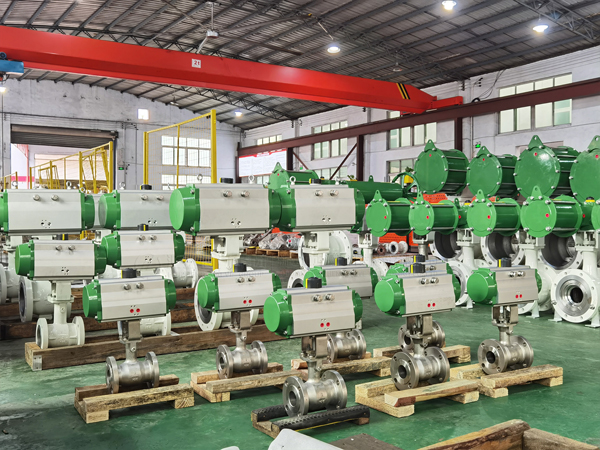
Engineers see that the big difference between an eccentric rotary control valve and a linear control valve is how each valve moves to control flow. Rotary control valves, like an electric ball valve or pneumatic ball valve, use a turning motion. Linear control valves, like the pneumatic control valve, move in a straight line. Each valve type works for different control needs. They give special benefits in flow control and sealing.
Eccentric Rotary Control Valve Overview
Design
Eccentric rotary control valves are special because their plug or disc is off-center. The plug does not sit in the middle of the valve body. It turns along a path that is not straight. This helps lower friction and stops the valve from wearing out fast. The plug only touches the seat when the valve is almost closed. This makes the valve last longer. The valve turns a quarter way to open or close. This lets people make quick and exact changes. When the valve is shut, it seals tightly. It works well even with high pressure or rough fluids. Engineers like this valve because it is strong and does not need much fixing. The design lets it control flow or just turn on and off. This makes it useful in many jobs.
Operation
Rotary control valves turn to control how much flows through. The off-center design helps the valve seal better. When the valve starts to open, the plug moves away from the seat. This keeps friction low and stops damage. The quarter-turn lets people control flow very well. The valve works with rough or sticky stuff. It does not wear out fast, so it needs less fixing. This saves time and money. Rotary valves also keep air from leaking out. This helps pneumatic systems work better. Many rotary control valves have end covers you can take off and parts you can swap. This makes fixing them faster and easier.
Tip: Eccentric rotary control valves can control flow more exactly than other rotary valves. This helps keep product quality steady in factories.
Applications
Many industries use rotary control valves for tough jobs. These valves work well with thick liquids, slurries, and harsh chemicals. Chemical plants, water treatment places, and power stations use them for steady flow control. The strong build lets the valve handle high pressure and rough materials. People use rotary control valves to control flow or just turn it on and off. The design lets you make small changes to flow, which is important when you need tight control. The valve lasts a long time and does not need much fixing, so it saves money in hard jobs.
| Application Area | Typical Use Case |
|---|---|
| Chemical Processing | Handling corrosive or viscous fluids |
| Water Treatment | Managing slurries and abrasive flows |
| Power Generation | Regulating high-pressure steam or gas |
| Food & Beverage | Controlling sticky or thick substances |
Rotary control valves give engineers a good way to handle tricky flow control. Their special design and how they work make them different from other control valves. That is why many industries pick them.
Linear Control Valves Overview
Design
Linear control valves have a simple design. They let people adjust flow very exactly. The valve trim is important for how the valve works. Engineers make the trim open slowly at first. It opens faster as the stem moves more. This helps the valve keep a steady link between stem position and flow rate. It works even when pressure changes. The flow coefficient (Cv) goes up as the stem moves. This makes control easy to predict. Linear valves work best when pressure stays the same. If pressure changes a lot, control can get less steady. Picking the right valve and trim helps keep it working well.
Note: Linear control valves match valve position to flow. This makes them easier to pick and size for many jobs.
Operation
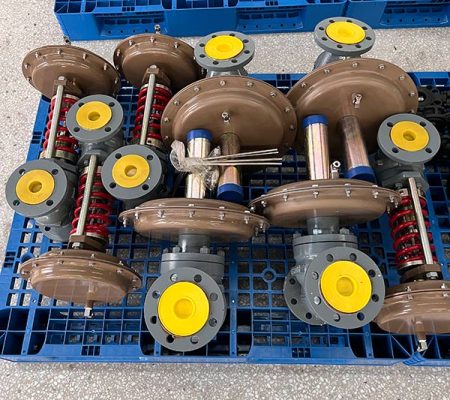
Linear control valves move the plug or disc in a straight line. This lets people control fluid flow very well. Globe valves are a common kind of linear valve. They give high accuracy and can handle many flow rates. The actuator type changes how fast the valve reacts. It can be pneumatic, hydraulic, or electric. Fast response helps make products better. Engineers must size the valve for the fluid and job. If the valve is too big, control is not as good. The right size makes control better and more efficient. Linear valves move in a way that helps keep control steady in factories.
- Linear control valves change flow with straight stem movement.
- Globe valves give high accuracy for exact control.
- The actuator type changes how fast the valve works.
- The right size helps control and product quality.
Applications
Linear control valves are great for jobs needing exact control. They help control flow, pressure, and temperature. Oil and gas plants use them for refining and pipelines. These jobs need very good flow and pressure control. Chemical plants use linear valves to control reactions and cut waste. Water and wastewater systems use them to keep flow steady and stop leaks. Power plants use linear control valves for steam and cooling water. This keeps things safe and efficient. Food and drug factories need valves that keep things clean and safe. Mining uses linear valves like pinch valves for rough slurries.
- Linear control valves work for jobs needing exact control.
- Main industries are oil and gas, chemicals, water, energy, drugs, food, and mining.
- Common types are globe, needle, and piston valves.
- These valves handle tough jobs and work with smart tech.
- Safety, efficiency, and rules make people use them in important jobs.
| Industry | Typical Application |
|---|---|
| Oil & Gas | Refining, pipeline flow and pressure control |
| Chemical Processing | Reaction control, less waste |
| Water/Wastewater | Flow control, stopping leaks |
| Power Generation | Steam and cooling water control |
| Pharmaceuticals/Food | Clean, corrosion-resistant control |
| Mining | Slurry and rough material handling |
Linear control valves help keep work steady and safe in many places. They give exact control and can handle hard jobs. This is why engineers like to use them.
Differences
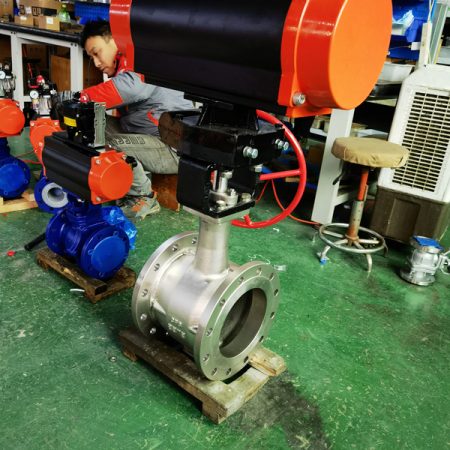
Movement Mechanism
Rotary control valves and linear control valves move in different ways. Rotary control valves turn a disc or plug to open or close. They only need a quarter-turn to work. The eccentric rotary control valve turns on an offset axis. This helps the valve seal better and last longer. Rotary valves use turning motion, so they are small and fast.
Linear control valves move the stem straight up and down. This pushes a plug or disc against the seat to open or close. The straight movement gives very exact control of flow. It also helps stop damage from cavitation.
Rotary control valves turn with an offset axis. Linear control valves move straight for exact flow control.
Flow Control Precision
How well a valve controls flow is very important. Linear control valves give very exact flow control. The stem moves straight, so you can make small changes. This is good when you need tight control.
Rotary control valves also control flow well. Their exactness depends on the design. Eccentric rotary control valves are better than regular rotary valves. The offset axis helps seal tight and lowers friction. Still, linear control valves are best for jobs needing the most exact flow control.
- Linear control valves: Best for very exact flow control.
- Rotary control valves: Good control, better with eccentric design, but not as exact as linear valves.
Structure
Rotary control valves and linear control valves look different inside. Rotary control valves have a small body. The disc or plug turns inside the valve. This makes the valve take up less space. The eccentric rotary control valve has an offset plug or disc. It only touches the seat when almost closed. This lowers wear and helps the valve last longer.
Linear control valves have a longer body. The stem moves up and down. The plug or disc moves across the seat. This makes the valve bigger but gives better control. Linear valves have more parts, so they are heavier and more complex.
| Feature | Rotary Control Valves | Linear Control Valves |
|---|---|---|
| Movement | Rotational (quarter-turn) | Straight-line (up/down) |
| Axis | Eccentric (offset) | Centered |
| Body Size | Compact | Larger |
| Wear | Reduced (seat contact near closure) | More uniform wear |
| Complexity | Fewer parts | More parts |
Rotary control valves are small and strong. Linear control valves are bigger and have more parts for better flow control.
Maintenance

Engineers look at how much work valves need. Rotary control valves have fewer moving parts. This means they wear out less and are easier to fix. The plug only touches the seat when closing. This lowers friction and helps the valve last longer. Many rotary valves let you take off covers and change parts fast. These valves do not need fixing as often. This saves time and money.
Linear control valves have more parts inside. The stem, plug, and seat touch all the time. This makes them wear out faster and need more fixing. To fix them, you must take apart the whole valve. Linear valves take longer to repair and need more downtime.
Tip: Rotary control valves are easier and faster to fix than linear ones. This can help busy plants save money.
| Feature | Rotary Control Valves | Linear Control Valves |
|---|---|---|
| Parts | Fewer, simpler | More, complex |
| Wear | Lower (seat contact at closure) | Higher (constant contact) |
| Service Access | Easy (removable covers) | Harder (full disassembly) |
| Downtime | Shorter | Longer |
Sealing
Sealing is important for safety and saving energy. Rotary control valves use an offset plug. The plug presses tight only when closing. This makes a strong seal and stops leaks. Rotary valves work with tough fluids and high pressure. The plug wipes the seat clean as it turns.
Linear control valves move the plug straight onto the seat. This gives good control and a tight seal. Globe valves seal well for many jobs. But the plug and seat touch all the time. This can wear them out and cause leaks later.
- Rotary control valves: Offset plug, tight seal when closed, less leaking, plug cleans seat.
- Linear control valves: Plug touches seat straight on, good control, tight seal, but more wear.
Pressure Handling

How valves handle pressure is a big difference. Rotary control valves have strong seats and small bodies. They work well with high pressure. The eccentric rotary design spreads pressure evenly. This helps the valve stay strong and work in tough places. Rotary valves are good for changing or high pressure.
Linear control valves also handle high pressure. Their straight movement helps control flow even when pressure changes. But their bigger bodies and more parts can make them less strong in very high pressure. Engineers pick linear valves for steady pressure and exact control.
Note: Rotary control valves are better for high pressure and tough jobs. Linear control valves are best for steady pressure and exact flow.
| Feature | Rotary Control Valves | Linear Control Valves |
|---|---|---|
| Pressure Resistance | High | High (but less robust) |
| Seat Strength | Strong, even pressure | Good, but more wear |
| Best Use | Fluctuating/high pressure | Stable pressure, fine control |
Rangeability
Rangeability means how well a control valve can change flow. It is important when you need both low and high flow rates. Rotary control valves, especially eccentric rotary types, have a wide rangeability. These valves use turning motion and a big flow coefficient. This lets them control flow over a wide range.
- Eccentric rotary control valves have much more rangeability than linear globe valves.
- The rotary design lets you adjust flow over a wide range. This makes these valves good for jobs with big flow changes.
- Rotary control valves have less friction. This helps the packing last longer and keeps control steady.
- These valves work with tough stuff like slurries, solids, and thick fluids. They do not lose control accuracy.
- Linear control valves, like globe valves, are very accurate but have less flow capacity and rangeability.
- Globe valves are best for steady flow. They may not work as well when flow changes a lot.
Note: Eccentric rotary control valves mix the exact control of globe valves with the high flow of rotary valves. This gives engineers more choices and strong valves for hard jobs.
Cavitation Resistance
Cavitation can hurt control valves and mess up flow. It happens when pressure drops and bubbles form and pop inside the valve. This can wear out valve parts and make control less accurate.
Rotary control valves, especially eccentric rotary types, fight cavitation better than many linear control valves. The turning motion and offset plug help spread pressure drops. This lowers the chance of bubbles and keeps the valve seat safe. Rotary control valves also work well with rough or gritty stuff. These things often cause cavitation in other valves.
Linear control valves, like globe valves, control flow very well but can have more cavitation problems. The straight movement and always touching the seat can make fast-moving spots where cavitation starts. Engineers must pick the right size or add special trims to stop cavitation.
- Rotary control valves: Better at stopping cavitation, even in tough jobs.
- Linear control valves: May need extra parts to handle cavitation in high-pressure or changing flow systems.
Actuators
Actuators move control valves to change flow. The kind of actuator depends on how the valve moves—rotary or linear. Each type has its own good points for controlling processes.
| Aspect | Rotary Control Valves (Eccentric Rotary) | Linear Control Valves (Globe, Pinch) |
|---|---|---|
| Valve Motion Type | Rotational movement (quarter-turn) | Linear movement (up/down) |
| Actuator Motion | Makes turning force | Makes straight force |
| Design & Space | Small, fits tight spaces | May need more room, but some are small |
| Force Output | High turning force for size | Adjustable straight force |
| Speed & Precision | Turns fast; may need extra parts for fine control | Very exact; can change stroke and speed |
| Control Mechanisms | Air/electric with feedback; may need extra parts | Air/electric with feedback; can change stroke |
| Maintenance | Needs fixing less often; seals and bearings wear | Needs fixing more often; seals and guides wear |
| Environmental Suitability | Good for dangerous places (does not spark) | Best in clean, safe places |
Rotary control valves use rotary actuators. These are small and give strong turning force. They work well in dangerous or small spaces. Linear control valves use linear actuators. These give exact movement and can change force. Both types can use electric, air, or hydraulic power. The best choice depends on the job and space.
Tip: Picking the right actuator helps control flow well and lowers fixing needs for both rotary and linear control valves.
Pros and Cons
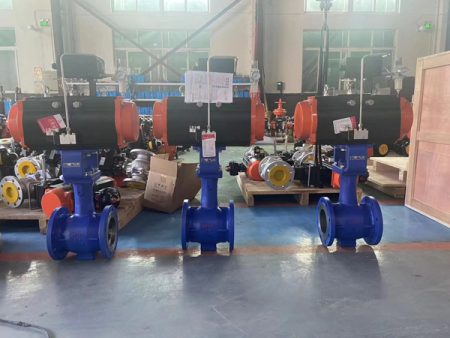
Rotary Control Valves
Rotary control valves have many good points.
- They let you control fluid flow very exactly, which helps in hard jobs.
- These valves can handle very hot or cold places and high pressure. This makes them good for chemical plants and power stations.
- They last a long time and can be used in water, energy, food, and drink jobs.
- New materials and better designs help them fight rust and last longer.
- They work with smart tech and can be used with automatic systems. This saves energy and helps things run better.
- Rotary valves are small and light, so they cost less and are easy to put in.
- Strong parts, like in plug valves, help them work well in tough places.
- Smart tech, like IoT, makes them easier to check and fix.
Rotary control valves help keep flow safe and steady, even when things get tough.
But rotary control valves have some problems too.
The way the flow moves inside can cause sudden turns and changes. This makes the flow lose energy and can cause spinning and friction. These things make the valve less efficient. Rotary valves do not work well with very high pressure drops, usually above 30-100 psi. For bigger pressure drops, globe valves are better. Steam can wear out rotary valves if the pressure is over 50 psi, so special designs are needed. Rotary valves are good for air and water but may not work well for steam unless made special.
Linear Control Valves
Linear control valves also have many good things for factories.
- Electric actuators help control speed and force very well, making flow better.
- Pneumatic actuators are simple and cheap, but sometimes they stick or move slow.
- Electric linear actuators use less energy and work better than air ones.
- Rising stem valves are picked for important jobs because they are reliable and quick.
- Smart digital positioners help find problems early and make fixing faster.
- These smart tools help factories work better and make better products.
- Special tests and tracking help plan repairs and keep valves working longer.
- Watching for leaks helps keep the plant safe and follow rules.
- New positioners can talk to many systems, making control easier in big plants.
Linear control valves help factories work better, make more money, and stay safe.
Still, linear control valves have some bad sides.
- Deadband means the valve waits before moving after a signal, which can make it go too far.
- Hysteresis means the valve acts different when the signal goes up or down because of loose parts.
- Stiction makes the valve stick and not move smoothly, which can make things unstable.
- Nonlinearity mixes these problems and makes the valve hard to control.
| Drawback | Explanation |
|---|---|
| Longer cycle times | Linear valves are slower than rotary valves. |
| Limited throttling | Gate valves, a kind of linear valve, do not control flow well. |
| High pressure drop | Globe valves need bigger actuators or more force because of pressure. |
| Unsuitability for control | Some linear valves, like gate valves, are not good for control jobs. |
Linear trim valves work best when the pressure drop stays the same. If the pressure changes a lot, small moves can make big flow changes. This can make the system unstable and hard to control.
Selection Guide
Application Needs
Engineers need to pick the right valve for each job. The kind of fluid, pressure, and temperature matter a lot. How much control you need is also important. For clean fluids, linear control valves work best. Globe valves give very accurate control. They can handle jobs where you need tight flow control. Eccentric rotary control valves are better for thick or dirty fluids. These valves do not clog easily. Their turning motion helps keep the seal working well. They work in sticky or dangerous places. Rotary valves are small and light. They fit in tight spaces and big pipes.
Tip: Rotary control valves last longer when sealing is important. They leak less because their packing does not wear out as fast.
| Application Factor | Best Choice |
|---|---|
| Clean, high-pressure | Linear control valve |
| Slurry, pulp, impure | Eccentric rotary control valve |
| Tight space | Eccentric rotary control valve |
| High accuracy needed | Linear control valve |
Cost Considerations
Cost is more than just buying the valve. You must think about fixing, downtime, and how easy it is to use. Eccentric rotary control valves cost less to buy, especially if they are big. They are lighter, so putting them in and fixing them costs less. Most of the money spent on valves is for fixing them. Rotary valves need less fixing because they are simple and their seals last longer. Linear control valves cost more and are heavier. But they can do more things and help control noise and cavitation. This means you may not need extra tools for hard jobs.
| Aspect | Eccentric Rotary Control Valve | Linear Control Valve |
|---|---|---|
| Purchase Price | Lower | Higher |
| Maintenance Handling | Easier | More difficult |
| Versatility | Less | More |
| Life Cycle Cost | Lower initial, still significant maintenance | Higher overall |
Note: Fixing valves can be most of the cost over time. Picking a valve that is easy to fix saves money later.
Reliability
Reliability means the valve works well and keeps things safe. Eccentric rotary control valves have seals that last a long time. Their turning motion keeps the packing from wearing out. This helps stop leaks and keeps the valve working well. Rotary valves seal better over time than linear valves. Linear control valves are best for jobs needing very exact control. They let you make small changes and work well even when things change. But they have more parts and move more, so they need fixing more often.
Engineers should think about the job, fluid, and how much control is needed. The best valve is reliable, easy to fix, and controls flow well.
Summary Table
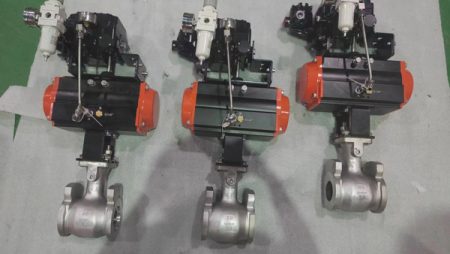
Quick Reference
Picking the best control valve depends on a few main things. Engineers need to compare valves side by side to choose fast. The table below shows the biggest differences between eccentric rotary control valves and linear control valves. Each row tells how the two types work in real jobs.
| Performance Metric | Eccentric Rotary Control Valve | Linear Control Valve (Globe Type) |
|---|---|---|
| Flow Capacity | About the same as globe valves; not double like some rotary valves | Standard flow changes with size and trim |
| Rangeability | High; small size and long-lasting stem seals | Many flow choices available |
| Noise & Cavitation | Less likely than segment ball valves; more than globe valves | Globe valves are better at stopping noise and cavitation |
| Cost | Usually costs less | Often costs more |
| Stem Seal Longevity | Lasts long because of rotary motion and less friction | Changes; globe valves may wear out faster |
| Typical Applications | Tough, small; good for places that care about emissions | Used a lot in refineries and process control |
Tip: Eccentric rotary control valves are tough and save money. Linear control valves give the best accuracy for important flow jobs.
Engineers also check how each valve reacts when flow changes. Linear control valves have a direct link between how much they open and the flow. Small moves make steady changes. Eccentric rotary control valves with equal percentage features control low flows better. They need more opening to reach full flow. This stops sudden jumps in flow.
| Metric | Linear Valve Characteristics | Equal Percentage (Rotary) Valve Characteristics |
|---|---|---|
| Valve Lift at Low Flow | Needs less lift (about 4% at 10% flow) | Needs more lift (about 20% at 10% flow) |
| Valve Lift at Max Flow | Needs less lift | Needs more lift |
| Flow Control Behavior | Straight link between lift and flow | Not straight; better at low flow |
| Steam Control Suitability | Not as good; opens fast | Better; opens slower, controls well |
| Valve Sizing | Might need to be bigger, which makes it act fast | More flexible and easier to control |
- Eccentric rotary control valves work great in hard places and small spaces.
- Linear control valves are best when you need high accuracy and steady flow.
- Rotary valves need less fixing and their seals last longer.
- Globe valves stop noise and cavitation better, so they are good for careful jobs.
Picking the right valve depends on what the job needs, the kind of fluid, and how exact the control must be. This table helps engineers match valve features to their job fast.
Eccentric rotary control valves turn to open and close. They work well with thick or rough fluids. Linear control valves move in a straight line. They help control flow very exactly. Rotary valves last a long time and are easy to fix. Linear valves are best for clean systems that need high accuracy. Engineers pick valves based on fluid, pressure, and what the job needs.
For hard jobs, engineers should ask valve experts for help. This keeps things safe and working well.
FAQ
What is the main difference between rotary and linear valves?
Rotary valves open and close by turning. Linear valves move up and down to work. Each type is good for different jobs in factories.
When should an engineer choose a rotary control valve?
Engineers pick rotary control valves for thick or dirty fluids. These valves fit in small spaces and handle high pressure. They also need less fixing.
Why do linear control valves offer high flow control precision?
Linear control valves are very exact because the stem moves straight. This lets you make small, careful changes to the flow.
Can rotary valves handle high-pressure drops?
Rotary valves can handle medium and high pressure drops. For very high pressure, engineers often use linear valves. These work better and are safer.
How does maintenance differ between rotary and linear valves?
Rotary valves have fewer parts, so they need less fixing. Linear valves have more parts that touch all the time. This means they may break more and need more repairs.
Which valve type is best for clean fluids?
Linear valves are best for clean fluids. Their design gives good control and strong sealing in clean systems.
Are rotary control valves suitable for automated systems?
Rotary control valves work well with automatic systems. They use electric or air power and react fast to signals.
What industries use linear control valves most?
Oil and gas, chemical plants, and water treatment use linear control valves. These valves help keep flow steady and meet strict rules.
